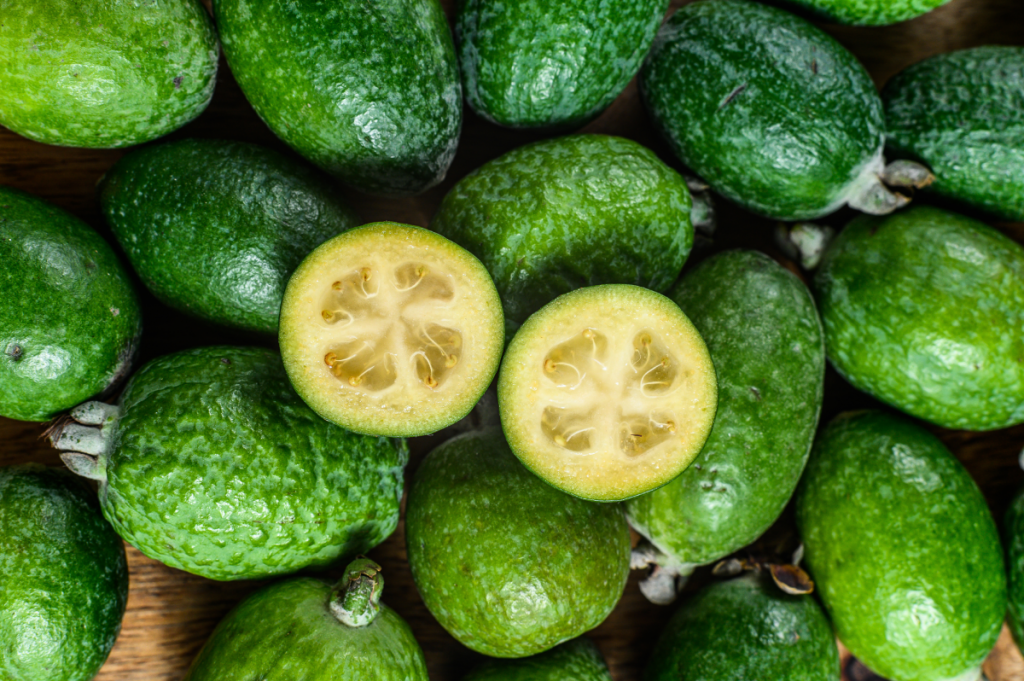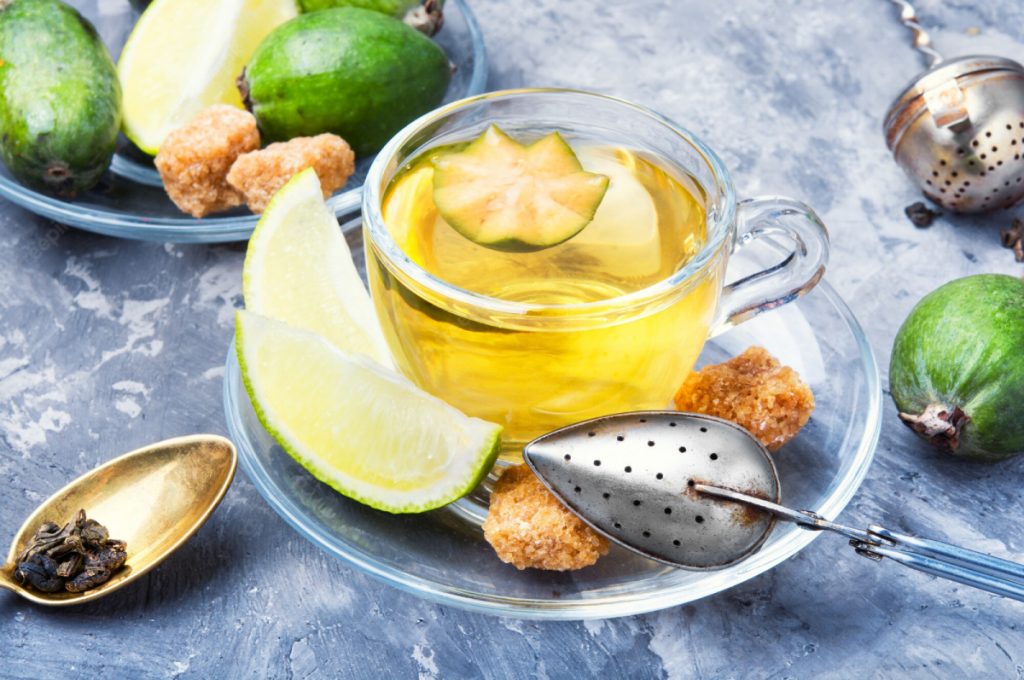Many of you would have heard about feijoa, some might have tasted it already. But for those who have never heard of this exotic yet common fruit in Australia and New Zealand, let’s get to know what it is and the nutritional values of feijoa, shall we?

What is Feijoa? What are they called in Australia? What country did it come from?
Feijoa (Acca sellowiana), pineapple guava, or guavasteen, is an exotic plant related to guava in the Myrtle family. It is a native fruit of southern Brazil, Paraguay, Uruguay, and some parts of Argentina. A German botanist Otto Karl Berg named the fruit in honour of the Brazilian naturalist Joao Da Silva Feijo. The plant was introduced into Europe in the 1890s and then imported into New Zealand around the 1920s. Ever since Feijoa has been very popular in New Zealand for generations. And over the last few decades, it has been rediscovered by home gardeners and commercial fruit growers.
What are the Characteristics of the Feijoa Fruit?
Feijoa fruits are oblong berries the size of an egg. They are covered with thin skin with a slightly hairy, rough or smooth epidermis, depending on the variety. When ripe, the wrapping can vary from yellow to green and give off a pleasant smell. In regions where the summer is prolonged and the temperatures are mild, feijoa will produce small green, tasty ovoids rich in vitamin C. The texture of the pulp is juicy in its centre and slightly grainy in its periphery. The aroma of this exotic fruit is unique and resembles a mixture of pineapple, guava and strawberry. It perfectly combines acidic and sweet flavours.
Though when the fruit is young, it has a pleasant acidic taste, when it is too ripe, it exhales a scent similar to turpentine.
The tree is about 5 metres (15 feet) high and has olive-like leaves, dark green above and silvery beneath. The large white flowers have purplish crimson interiors. Feijoas are propagated by seeds, cuttings, whip grafting, and layering of low branches.

Usage of feijoa
- The fruit is mainly eaten fresh however due to the short season sometime around autumn. Feijoas are used in cooking and preserved.
- It’s not only the feijoa fruit that’s edible! You can also eat the flower petals! With a sweet and musky taste, they make a great addition to salads.
- Originally the native tribes of South America used the leaves of the feijoa to make a liquid potion for medicinal purposes. Today in parts of Eastern Europe, The Caucasus and other parts of the ex-Soviet Union countries, feijoa leaves are brewed as a tea.
- Feijoa can be pruned to topiary forms or espaliered (trained to grow along a fence).
Nutrition and Benefits
- Feijoas are low in calories; 100 g of fresh fruit holds only 55 calories. Nonetheless, they are low-fat, cholesterol-free fruits loaded with vitamins, and antioxidants that assure you a healthy state of well-being, free from illnesses.
- The fruit is a very rich source of soluble dietary fibre (6.4 g per 100 g of fruit, about 17% of DRA), which makes it a good bulk laxative. The fibre content helps protect the colon mucous membrane by decreasing exposure time to toxins as well as binding to cancer-causing chemicals in the colon.
- Feijoa fruit is an excellent source of antioxidant vitamin C. 100 g of fresh fruit provides 32.9 mg of vitamin C, about 55% of DRI (daily recommended intake). Vitamin C is a water-soluble antioxidant that works well against viral illness through immune-boosting means. Regular consumption of fruits rich in vitamin C helps the human body develop resistance against infectious agents and scavenge cancer-causing harmful free radicals from the body.
- Feijoa contains small proportions of B-complex vitamins such as pantothenic acid, niacin, vitamin B6 (pyridoxine), and vitamins E and K, as well as minerals like calcium, magnesium, copper, and manganese.
Commercialisation
It is recorded that in 1890, a botanist named Edouard Andre brought the first samples back to his country of origin in France where the cultivars were improved and distributed to other parts of the world from there. The feijoa plant was also grown as an ornamental in gardens.
Today New Zealand is by far the leader in the feijoa industry. Since the early 20th century, New Zealand has been developing new and improved varieties of feijoas, many of that are now grown commercially worldwide. New Zealand is also the largest producer of feijoas, estimated to be more than 800 tonnes per year.

Other countries that are known to grow Feijoas commercially are the USA (mainly California), Colombia, Chile, Brazil, Uruguay, France, Italy, Russia, Georgia, Azerbaijan, Armenia, Turkey, Israel, Australia, Japan and China.
Feijoas are technically available worldwide, but invariably in small quantities at exorbitant prices at boutique grocers. Like dragonfruit or any other exotic fruit that no one knows what to do with. They have low name recognition, therefore, low market demand,
“To get consumers to walk in and pick it (feijoa) off the shelf, that’s a challenge, because they don’t know what they’re buying. But these things take time. Other fruits have done it.”
Todd Abrahams, the managing director of Pole to Pole and director of the grower-owned Zeijoa
The Guardian

